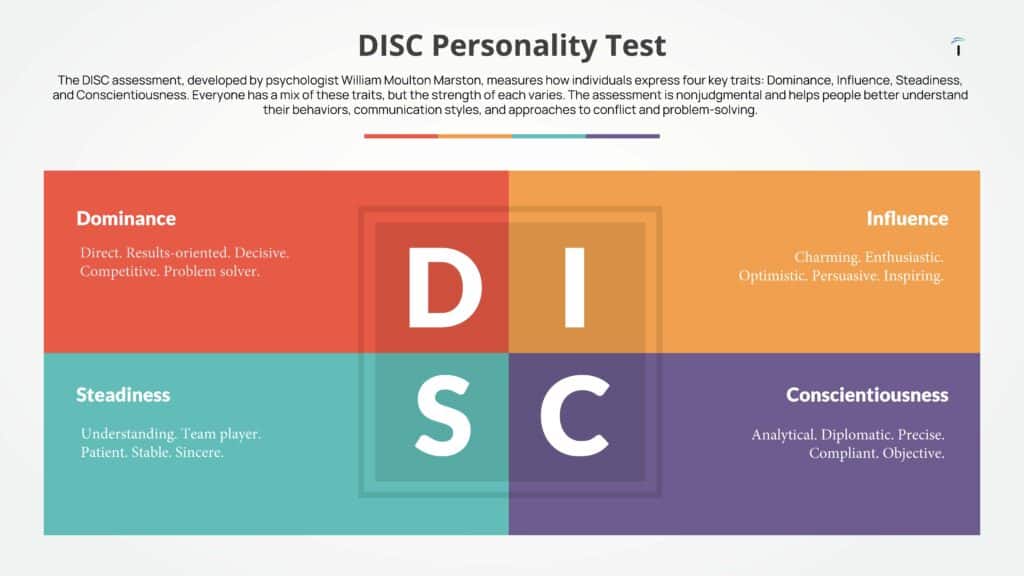
Why You’re Losing Your High Performers
High performers can be your greatest asset—if you understand what makes them tick. Ever had a star employee hand in their resignation letter sooner than you expected? It’s easy to blame managers for not motivating or developing them properly, but sometimes HR or the hiring manager could have dealt them a better hand from the start.
Understanding what excites or frustrates an employee early on is critical. It helps to build the right team chemistry well before the first day of employment. Finding the right chemistry means matching the most compatible person to the job you’re hiring them to do—not just hoping they’ll fit.
One simple, powerful tool to do this? The DISC profile. Using DISC profiles during hiring can quickly give you valuable insight, helping you to predict how someone will perform not just in the job, but within the team dynamic. Relying on background checks and gut instinct alone is risky when you don’t fully understand how a new hire will interact with the rest of the team.
What is the DISC Profile?
The DISC profile is a behavioral assessment tool that identifies how individuals naturally communicate, make decisions, and work. It breaks behavior down into four main types:
- D – Dominance: Results-driven, decisive, competitive.
- I – Influence: Social, enthusiastic, persuasive.
- S – Steadiness: Loyal, calm, patient, dependable.
- C – Conscientiousness: Analytical, precise, detail-oriented.
Everyone is a blend of these four styles, but usually one or two are most dominant.
Quick examples:
- D (Dominance): A CEO who makes quick decisions under pressure, focused on winning and hitting goals. Likes challenges and control, but can be blunt or impatient.
- I (Influence): A sales manager who motivates the team with high energy and builds strong client relationships. Loves collaboration and recognition, but may overlook details.
- S (Steadiness): An HR specialist who is the steady, reliable support system for the team. Values stability and harmony but may resist change.
- C (Conscientiousness): A financial analyst who double-checks every spreadsheet. Focused on quality and accuracy, but may get stuck in perfectionism.
Why Matching Style to Role Matters
If you know an employee is a high performer, it’s crucial to understand what will keep them engaged. Dave Ramsey shared a great example on his podcast, EntreLeadership: a high-performing HVAC contractor felt disengaged. After some questioning, they uncovered that he loved negotiation but hated numbers. Translation? He’s most likely a D style, not a C.
In another blunt but true example, Ramsey says:
“If you are a high D and you hire a high S as your assistant, they are going to cry every day.”
Perpendicular styles can create unnecessary conflict. Similarly, putting a fast-moving I-style employee in a slow, methodical C-style environment can make them seem reckless or untrustworthy to the team.
As companies grow, it’s easy to stack new responsibilities onto existing roles. But that doesn’t mean employees will stay energized by all the changes. Doing regular assessments helps ensure you’re keeping engagement high and aligning roles with people’s strengths.
Key Questions to Ask
When hiring (or reassessing your team), think beyond skills and experience:
- How do they function under pressure?
- How do they interact with different personalities?
- How will they mesh with the chemistry of the team they’re joining?
For example:
A loud, outgoing I can thrive in sales—but put them in accounting, and it could be a disaster. Similarly, a detail-hating, fast decision-maker shouldn’t be running your books.
High performers are one of your organization’s most valuable resources—but keeping them inspired, supported, and aligned is a delicate dance. Sustaining ultimate performance takes tenacity, determination, and consistent motivation.
Nobody—no matter how steady—is a machine. It’s tough to maintain peak performance across an entire career. But at their core, high performers want to keep succeeding. That desire is a value your organization should nurture, reward, and never take for granted. Make sure you put them in an environment where they will find enjoyment and naturally succeed.

Advice in Your Inbox
Join our newsletter for free bi-monthly toolkits and downloads on how to hire, support, and retain your best talent.







